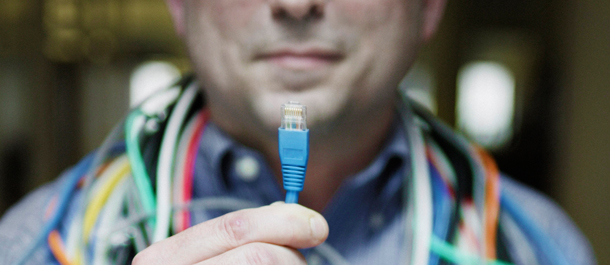Counterfeit Cable: More Widespread Than You Think

The shady-looking character in a trench coat on a street corner leans toward you and whispers, "Psst... buddy, wanna buy some cable?" While this image may be more stereotypical for selling fake Rolexes, counterfeit cables are a growing problem in the global marketplace for networking solutions. It is important to avoid the traps set by low-end manufacturers and sellers who present deceptive products. Counterfeit and non-compliant cable can result in a variety of risks, including costly repairs, legal issues, property damage, and even loss of life.
A 2012 independent study of offshore manufactured cable discovered some startling results. The tests, commissioned by the Communications Cable & Connectivity Association (CCCA), sampled cables from the inventory of six distributors in North America. The six chosen brands were considered "unknown" by most buyers. The tests found that five of the six samples failed to meet minimum National Fire Protection Association (NFPA) code requirements for low flame spread and/or smoke generation. In addition, four of the five cables that failed the fire requirements also failed to meet minimum electrical performance required by Cat 5e and Cat 6 standards.
These types of failures have huge ramifications when installed in a commercial building. So if you're specifying, buying, or installing cable, it is important to recognize the signs of counterfeit and non-compliant cable.
Counterfeit Cable
Brand names are important and valued assets of a corporation, and they communicate to the consumer a level of quality and expected performance standards. When a low-cost, low-quality manufacturer tries to use a respected manufacturer's brand, they are stealing from both the consumer and the name-brand manufacturer. We call those goods "counterfeit." But a variety of other dishonest or deceptive practices have been detected in the marketplace.
A cable might be properly identified as coming from a given manufacturer, but it can be falsely labeled as complying with industry standards and being certified (e.g., using UL or ETL marks), giving a deceptive claim as to the cable's review by a third-party testing laboratory. These cables are described as "bearing counterfeit certification," and put networks at risk by deceiving an end user as to the verified properties of the cable. Counterfeit cable may also include misleading or false claims, such as being "plenum rated". In 2010, Underwriters Laboratories (UL) fought back against counterfeiters by requiring holographic certification labels on cable reels and boxes.
Non-Compliant Cable
Some cables or patch cords may not be falsely labeled, but could be deceiving nonetheless. If the product does not state that a given standard is adhered to, but the seller claims or implies that it does, this can cause additional problems for the end user. Cables sold for abnormally low prices or by distributors without a track record with a given brand are suspect. The CCCA recommends that the best way for end users to protect themselves is to specify and then validate their cable is from a well-known supplier with a well-recognized brand. Another CCCA test found an 85 percent failure rate for Cat 6 patch cords with unknown brand names, and a zero percent failure rate from reputable brands.
Copper-Clad Aluminum
A particularly dangerous type of non-compliant cable is Copper-Clad Aluminum (CCA). This cable is sold at very low prices since a large percentage of the metal is aluminum instead of copper. The problem is the performance degrades significantly with CCA and therefore does not comply with industry standards, including UL and TIA. The cable can become brittle and connections become increasingly unreliable over time. But sellers of CCA cables are relying on the attractiveness of the low price to dupe buyers into a path they will later regret.
The bottom line: if the price seems too good to be true, it probably is. Leviton joins with the many other members of the CCCA in committing to provide quality solutions. We encourage buyers to be careful and buy from reliable brands and distributors to assure long-term reliability of their networks. The CCCA offers a free app to help identify non-compliant and counterfeit data cable. Visit www.cccassoc.org.
Counterfeit/Non-compliant Cables
1. Very low price, well below market norms
2. Low performance materials substituted for jacket and insulation
3. Poor printing and typographical errors
4. Lighter weight: boxes of cable with copper-clad aluminum weigh
considerably less that solid copper cable
5. Private-labeled, unfamiliar brands from offshort manufacturers
6. Supplied only through website or local storefront distributors
7. No information on factory location or country of origin
8. No spec sheet available
9. Use the CCCA CableCheck mobile app or go to cccassoc.org for help


